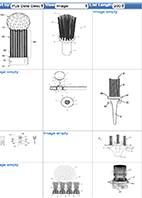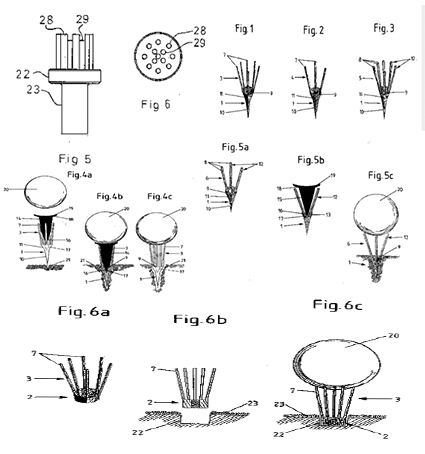Marketing patents – Brush-T success story
The bristled golf tee known as a BRUSH-T, launched in 2000, has been a great commercial success – many golfers have tried it; nearly all are aware of it.
A quick search through the patent databases shows various “knock-off” products have been invented, design registered, and patented:

And, many of these “copycat products” are on sale:

So, how did the BRUSH-T become such a great success? Was it due to a strong patent? Or is it 100% attributable to marketing? And, who copied whom?
Also see Iptica Patent Pending Number for tips on using patents for marketing ‐ stamp “Patent Pending” prominently on the front of your product; use the patent drawing; and carefully consider the title.

Brush-T refers to patents often. But, search on Google – you will find many articles, but no reference to a single patent number. What does their patent cover? Brush-T never elaborates.
On October 27 2004, Brush-T announced with much media fanfare that “it has received US Patent Approval on its unique Brush-T bristle tee application.” Congratulations. But, they don’t have a US patent. What is going on?

This is their story:
On 25 February 1999, Jason Lee Crouse filed a South African provisional patent no. ZA99/0825 for a “BRUSH-TEE”. Filing a provisional patent is step 1 of the patenting process. The provisional patent included the following Figures and a very short description:

On 2 February 2000, Crouse filed a corresponding PCT / international patent application no. WO00/45905. Filing a PCT patent is the second step of the patenting process:

Claim 1 of the PCT patent reads:
“A device for supporting a ball on a ground surface, the device including:
a base;
engagement means for engaging the base to the ground surface; and
at least one elongated resilient support member, extending from the base, which defines a support surface for supporting the ball.”
A few words about patent claims: this is the section of the patent that sets out the monopoly. For a competitor to infringe a claim the competing product must include all the features in the claim. The fact that the competing product has many additional features is not relevant. But, if the competing product excludes a single feature in claim 1, that product will not infringe claim 1.
To be valid, claim 1 must be “novel / new” (tested worldwide) and “inventive” (i.e. not obvious to an expert in the field). In this regard, the European Patent Office was appointed to determine whether the “elongated resilient support member” was “new”.
Three months later, the European Patent Office issued a search report that cited three prior art patents (GB2258161, WO95/07118 and DE9005261) as being “of particular relevance; the claimed invention cannot be considered novel or cannot be considered to involve an inventive step when the document is taken alone“:

True. These prior art patents did destroy the “novelty” of claim 1. Consequently, Brush-T amended claim 1 of the PCT patent to read:
“A golf tee for supporting a golf ball on a ground surface, the golf tee including:
a base defining an operatively upper face and an opposed operatively lower face;
a pointed shaft extending from the lower face, which is arranged to be pushed into the ground surface; and
a plurality of bristles which extend from the upper face of the base in a vertical orientation relative to the base,
wherein the bristles are arranged to define an annular support surface for supporting the golf ball, characterized in that the annular support surface has an inside radius of 5mm and an outside radius of 7.5mm.”
This revised claim was subsequently found by the PCT examiner (European Patent Office) to be novel and inventive.
However, since the specific dimensions of the annular support surface were not described in the South African provisional patent, the PCT patent’s “claim to priority” was effectively lost. In other words, any public disclosure of these dimensions (even by Brush-T itself) during the period 25 February 1999 to 2 February 2000 would have destroyed Brush-T’s patent rights worldwide.
Let’s stop here for a second and consider what most patentees would have done: your priority date is lost, and the prior art describes all the features in your original claim. Your only option is to claim specific internal and external radii. Would the Brush-T work with:
- an outer radius 7.4mm and below?
- an outer radius 7.6mm and above?
- an inside radius 4.9mm and below? or
- an inside radius 5.1mm and above?
Yes, Yes, Yes and Yes. And, none of these “modified” brush tees would infringe this amended claim! So, why continue ploughing money into patents that cover this very narrow claim?
By 25 August 2001, Brush-T had to decide in which countries this PCT patent was to be extended. Filing “national phase” patents is step 3 of the patenting process. National phase patents were filed in Europe, Australia, New Zealand, Canada, Hong Kong, Japan and South Africa.
You will notice that no national phase patent appears to have been filed in the US. But, what about the “US patent” referred to in Brush-T’s media splash on 27 October 2004? Small typo: this “US patent” actually refers to a “US design patent”. Design registrations protect the shape of a product, and are very easy to get. And, yes, on 15 June 2004, this US design patent was granted:

On 6 March 2000 (i.e. before receiving the bad news in the PCT patent search report), Brush-T submitted one of its tees to the USGA for “approval”. Decision 2000-99 of the USGA referred to “the Brush-T golf tees submitted for an official ruling” and advised that “the golf tees, as submitted, have been inspected and it has been determined that the use of these tees would not violate the Rules of Golf.” It is not clear whether these tees submitted to the USGA defined an annular support with an inside radius of exactly 5mm and an outside radius of exactly 7.5mm. Does the USGA approval on the one hand and the Brush-T patents on the other hand tie up?
Even if the BRUSH-T was not an innovative product, Brush-T is a very innovative company. They truly appreciated the value of patents: not as a right to keep competitors out of the market; but as a marketing tool. By:
- shouting that the Brush-T was patented from every rooftop;
- never mentioning a patent number; and
- claiming that their “patented” golf tee is “permitted under the USGA Rules of Golf”.
Brush-T has successfully consolidated its No.1 position in the bristled golf tee market. Their patents, which would struggle to take candy from children, have kept mature competitors at bay. Does this not highlight the true value of patents – being able to say that your product is “patented”?
… and hoping that no-one ever calls your bluff with a 4.9mm inside diameter annular support surface.
